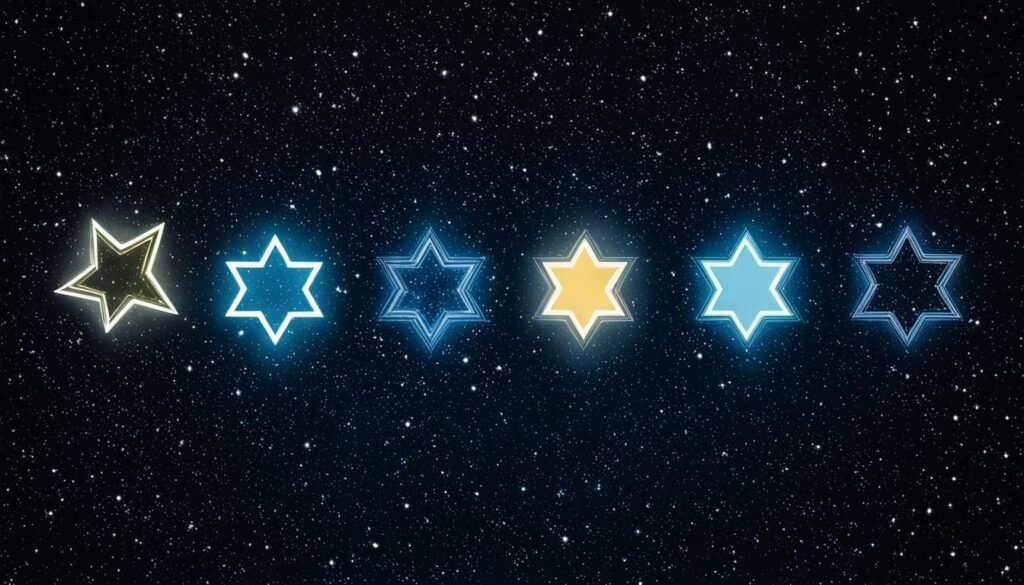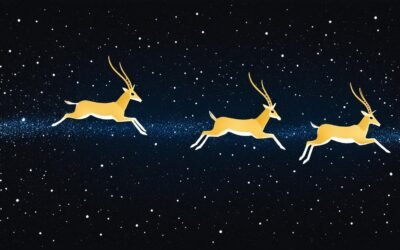As you peer into the winter night sky, a grand spectacle awaits you—the Winter Hexagon asterism. This celestial landmark is a beacon for stargazers, guiding eyes and telescopes alike to a collection of seven of the most luminous stars known to humanity. Each point of light is a story in itself, tracing back to the myths and legacies that have adorned the sky for millennia. Unveil the mysteries of the heavens as you delve into the allure of what is also known as the Winter Circle, an asterism highlighted by the radiant Sirius in Canis Major, the golden Capella in Auriga, and the brilliant Rigel in Orion’s constellation, among others. As you gaze upwards, the Winter Hexagon traces a pathway along the Milky Way, giving you a glimpse of celestial grandeur on crisp winter evenings.
Not to be mistaken for a constellation, the Winter Hexagon asterism is a pattern made up of stars from different constellations, forming a shape that has captivated those looking up at the winter night sky. This astral configuration is visible predominantly in the northern hemisphere from December to March and is unobservable from far southern locales such as South Chile or the South Island of New Zealand. However, the night sky warmly opens its arms to include an extended version, known as the “summer hexagon,” when the bright star Canopus joins the array in southern skies. The Winter Hexagon serves as more than just a wintry landmark—it encompasses the smaller, yet equally striking Winter Triangle asterism and acts as a portal to further cosmic exploration.
Key Takeaways
- Discover the Winter Hexagon asterism, a dazzling array of stars lighting up the winter night sky.
- Understand the difference between asterism and constellation while enjoying the winter sky’s most highlighted feature.
- Explore the inclusivity of the smaller Winter Triangle asterism nestled within the larger hexagonal pattern.
- Embark on celestial navigation as the Winter Hexagon serves as a guidepost to deeper astronomical wonders.
- Experience stargazing at its best by seeking out the Winter Hexagon when it is most visible during the colder months.
Discovering the Winter Hexagon Asterism in the Night Sky
When the chill of winter cloaks the sky, your gaze can be rewarded with the celestial splendor of the Winter Hexagon asterism. This celestial highlight reel features the brightest stars, intricately woven into the fabric of the winter constellations. But before you embark on locating these stellar giants, let’s get acquainted with the basics of this star pattern.
Understanding the Basics of the Winter Hexagon
The Winter Hexagon isn’t a single entity but rather a grand assembly of bright stars from various winter constellations. Interestingly, it’s not to be mistaken for a constellation itself. Beloved by stargazers and heralded as a beacon in the winter night sky, this asterism is a stunning guidepost for exploring other celestial objects. Nestled within its bounds is the Winter Triangle, each point a stellar showcase, enhancing the allure for anyone admiring the night sky’s tapestry.
Finding the Stellar Giants That Comprise the Winter Hexagon
The stars that form the Winter Hexagon are not only bright; they are titans in their own right, each stemming from distinct winter constellations. This table below provides a glimpse into the celestials that make up the grandeur of the Winter Hexagon, ensuring you’ve got the knowledge to identify these luminaries as they shine above.
| Celestial Body | Constellation | Visual Magnitude | Notable Fact |
|---|---|---|---|
| Sirius | Canis Major | -1.46 | It’s the brightest star in Earth’s night sky. |
| Capella | Auriga | 0.08 | Actually a quadruple star system. |
| Rigel | Orion | 0.13 | It’s a blue supergiant, over 50,000 times brighter than our Sun. |
| Procyon | Canis Minor | 0.34 | Part of the Winter Triangle and the 8th brightest star in the sky. |
| Aldebaran | Taurus | 0.85 | This red giant star marks the eye of the Taurus constellation. |
| Pollux | Gemini | 1.14 | Pollux is the brighter of the twins, with an exoplanet in orbit. |
| Castor | Gemini | 1.58 | A complex star system consisting of six individual stars. |
Whether you are an experienced skywatcher or just beginning to dip your toes into the cosmic ocean, the Winter Hexagon is your gateway to marveling at some of the night sky’s most distinguished bright stars. These celestial beacons within the winter constellations offer a galaxy’s worth of wonder, right from your own backyard.
An Astronomer’s Guide to the Stars of the Winter Hexagon Asterism
As you become more involved in skywatching, the winter hexagon asterism beckons as a celestial highlight. This striking pattern adorning the winter sky features bright stars, each offering its unique splendor for observers. Let us embark on a stellar journey to acquaint you with these luminous landmarks.

Sirius, known as the Dog Star, is not only the brightest star in the winter hexagon but also claims the title of the brightest star in our night sky. Commanding attention with its brilliant light, Sirius is a double star system that includes a white dwarf companion, intriguing astronomers and stargazers alike.
In contrast, Capella, the sixth brightest star visible from Earth, presents itself as a quadruple star system. Found in the constellation of Auriga, it provides a more complex observation, proving that appearances in the cosmos can be deceivingly intricate.
Advancing to Orion’s constellation, we encounter Rigel and Procyon, ranking as the seventh and eighth brightest stars, respectively. Rigel, Orion’s foot, offers a visual feast as part of a multiple star system, whereas Procyon, the Little Dog Star, shares its luminary status in Canis Minor as a binary system.
- Aldebaran, the glowing eye of the Taurus constellation, stands as the fourteenth brightest star, famous for its distinct reddish hue, enriching the pattern of the Winter Hexagon with its warmth.
- Pollux, the radiant seventeenth brightest star, represents one half of the Gemini twins, complementing its sibling Castor, further enriching the winter tableau.
- Castor, though less bright as the twenty-fourth star, is known for being a sextuple star system, adding a layer of complexity to Gemini’s celestial narrative.
Each one of these stellar giants not only anchors the Winter Hexagon asterism, but they also serve as important indicators for celestial navigation and markers of the changing seasons in the night sky. As you embark on your skywatching adventures, remember that these stars are not just points of light but are cosmic wonders with stories and secrets awaiting your discovery.
Navigating the Winter Sky Using the Winter Hexagon Asterism
For those of you who relish the crisp night air and the thrill of unraveling the universe’s mysteries, skywatching during the winter months offers a grand tableau of celestial objects. The Winter Hexagon asterism is a luminous compass that guides stargazers through the most fascinating portions of the winter constellations. As your eyes adapt to the darkness, let’s embark on a star-hopping voyage that reveals the splendor of the night sky, one star at a time.
From Rigel to Sirius: A Star-Hopping Journey
Imagine connecting the dots on nature’s largest canvas as you journey from the fire-footed Rigel to the gleaming Sirius, drawing an imaginary line through the night’s beacons. Your excursion begins with Orion’s Rigel, a star that anchors your gaze, serving as a radiant starting point for your stargazing adventure. Next, you’ll navigate towards the illustrious twins of Gemini, Pollux, and Castor, whose light has traveled the cosmos to dance before your eyes. The crowning jewel of your skyward quest is Sirius, the diamond that marks the epitome of celestial discovery, searing brilliantly in the firmament.
Locating Deep Sky Objects Within the Winter Hexagon
The Winter Hexagon isn’t merely a guide to stars but a gateway to deeper cosmic wonders. Within its perimeter, myriad deep sky objects lie hidden to the unaided eye but reveal themselves to those with patience and a little magnification.
| Constellation | Celestial Object | Type | Notable Feature |
|---|---|---|---|
| Orion | M42 – Orion Nebula | Nebula | Stellar nursery visible to the naked eye |
| Gemini | M35 – Open Star Cluster | Star Cluster | Rich cluster easily visible through binoculars |
| Canis Major | NGC 2359 – Thor’s Helmet | Nebula | An emission nebula resembling a mythical helmet |
| Auriga | M36, M37, M38 – Star Clusters | Star Clusters | Three prominent clusters available for side-by-side comparison |
| Canis Minor | NGC 2485 – Galaxy | Galaxy | A faint galaxy for seasoned observers |
| Taurus | M1 – Crab Nebula | Supernova Remnant | Site of the historical supernova observed in 1054 AD |
Exploring the Bright Stars That Illuminate the Winter Night Sky
When you venture out into the crisp, clear evenings of winter to engage in some stargazing, you’re not just looking at points of light. Each star in the winter hexagon asterism tells a story, etched into both sky and myth. The brilliance of these bright stars punctuates the winter sky, transforming a casual glance upward into a journey through the ages.
Take, for example, Aldebaran, known as “the follower” due to its position that appears to trail the Pleiades cluster across the sky. Its reddish hue signals its ancientness, an aging giant worthy of its name and folklore. Then there are the twins, Castor and Pollux, making up the constellation Gemini. They represent a dichotomy in the heavens – one immortal, the other mortal – and bring with them a diversity of tales and scientific wonders.

Let’s not forget the vibrant Capella in Auriga, a binary system where two giant stars orbit each other in a celestial dance that has captivated astronomers for centuries. Similarly, the brilliant Rigel marks Orion’s foot, a beacon for those scanning the constellations. And no mention of the winter’s night sky would be complete without Sirius, known as the “Dog Star,” the brightest star in our night sky and a key luminary for navigators past and present.
Here’s a closer look at how these stars distinguish themselves:
- Aldebaran: An orange giant star approximating the fiery eye of Taurus the Bull.
- Castor and Pollux: Not one but a wondrous twin system, comprising a hot white star and a cool golden star, exemplifying contrasting stellar phenomena.
- Capella: Closer inspection reveals not just one star, but a group of four, wheeling through the galaxy together.
- Rigel: Burning bright with a blue-white radiance that marks it as a fledgling in the company of these ancient bodies.
- Sirius: Double the intrigue with its companion, a white dwarf, its twinkle has guided generations.
This assembly of bright stars provides not only a spectacle for your eyes but also serves as a cosmic canvas for storytelling. As you observe the sky, remember you’re witnessing the same patterns that navigators, poets, and astronomers marveled at throughout history. The winter hexagon asterism is more than just a celestial landmark; it’s a crossroad of human curiosity and the vast, unfathomable universe.
Connecting the Dots: Winter Hexagon Asterism and Other Celestial Patterns
As you glide your gaze across the winter night sky, you’re not just looking at a sprinkling of stars—you’re engaging with a cosmic map etched with star patterns and constellations that have guided humanity for millennia. The Winter Hexagon asterism stands out as one of the celestial objects that tie the night together, forming a nexus point for stargazers young and old. Within this majestic hexagonal arrangement is another wonder, a pattern within a pattern, that serves as both a navigation aid and a stunning visual spectacle.
The Winter Triangle: An Asterism Within an Asterism
The intimacy of the Winter Triangle offers a sharp contrast to the expansive enclosure of the Winter Hexagon. Focalizing on Betelgeuse, Sirius, and Procyon, you’ll notice how this compact formation punctuates the frigid canvas of the winter constellations. Betelgeuse’s reddish twinkle creates a vibrant centerpiece, surrounded by the brilliant blue-white glints of Sirius and Procyon. This trio not only provides a smaller scale to discover but also a gateway to deeper cosmic exploration and stargazing success for those just delving into the night sky’s rich tapestry.
Expanding the View: From Winter to Summer Hexagon
As the seasons progress, those in northern climes give way to viewers south of the equator, where an expanded version of the hexagon, inclusive of Canopus, denotes the ‘summer hexagon’. It’s a shifting celestial stage, reminding you of the interconnectedness of star patterns—how they evolve with latitude and time, creating a dynamic, year-round celestial showcase. Next time you celebrate a clear winter night under the stars, remember, you’re tracing lines of a heritage that binds the winter constellations to their summer counterparts, each significant under its hemisphere’s gaze.
FAQ
What is the Winter Hexagon Asterism?
The Winter Hexagon Asterism, sometimes known as the Winter Circle, is a prominent asterism formed by seven bright stars from various winter constellations: Sirius, Capella, Rigel, Procyon, Aldebaran, Pollux, and Castor. It’s visible primarily during the winter months in the northern hemisphere.
Can the Winter Hexagon Asterism be seen all year round?
No, the Winter Hexagon Asterism is best seen from December to March in the northern hemisphere when the winter constellations are most visible in the night sky. Its appearance changes throughout the year due to Earth’s orbit.
How do I locate the Winter Hexagon Asterism in the night sky?
To locate the Winter Hexagon Asterism, you should find its brightest star, Sirius, which is also the brightest star in the night sky. From there, you can trace the hexagonal shape by locating the other bright stars of Rigel, Aldebaran, Capella, Pollux and Castor, and then to Procyon, to complete the pattern.
Is the Winter Hexagon the same as a constellation?
No, an asterism is a pattern of stars recognized in the night sky, which can include stars from multiple constellations. A constellation is a specific area of the night sky that includes a standardized pattern recognized by the International Astronomical Union.
What is the Winter Triangle?
The Winter Triangle is a smaller asterism within the larger Winter Hexagon, formed by three of its stars: Sirius, Procyon, and Betelgeuse from Orion. This is an easier pattern to spot and is a good starting point for novice stargazers.
Can you see the Winter Hexagon Asterism from the southern hemisphere?
The Winter Hexagon Asterism as it is seen from the northern hemisphere is not visible from extreme southern locations. However, in the southern hemisphere, a similar asterism known as the Summer Hexagon is visible, which includes six of the same stars plus Canopus.
What other celestial objects can be found within the Winter Hexagon?
The Winter Hexagon encapsulates a section of the Milky Way, offering a gateway to observe other deep-sky objects like star clusters, nebulas, and galaxies that lie along the same line of sight.
Why are the stars in the Winter Hexagon so bright?
The stars in the Winter Hexagon are among the brightest in the night sky due to their relative proximity to Earth and their intrinsic luminosity. They include a mix of giant and supergiant stars, as well as multiple star systems that contribute to their apparent brightness.
What is the best time to view the Winter Hexagon Asterism?
The best time to view the Winter Hexagon Asterism is on clear winter nights from December through March, after sunset and before midnight, when the asterism is at its highest point in the sky.
How is the Winter Hexagon useful for stargazing and celestial navigation?
The Winter Hexagon serves as a celestial landmark for stargazers, helping to identify and locate various bright stars and constellations in the winter night sky. Its prominent stars also historically aid in celestial navigation, helping to pin-point one’s location relative to the stars.
Are there any myths or legends associated with the Winter Hexagon stars?
Yes, many of the stars in the Winter Hexagon have fascinating mythological stories associated with them, particularly with the constellations they belong to, such as Orion the hunter, the twins Castor and Pollux of Gemini, and Taurus the bull.
What equipment do I need to observe the Winter Hexagon?
The Winter Hexagon can be seen with the naked eye under good conditions. However, a pair of binoculars or a small telescope could enhance the viewing experience, particularly for observing deep-sky objects within the asterism’s boundaries.






